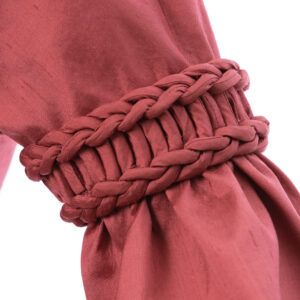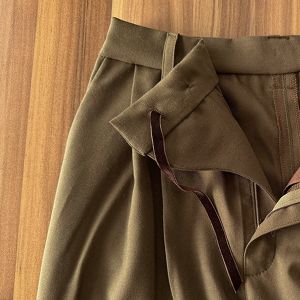Plus – sized draping part 2 sleeves! maybe now I can get a sleeve that fits?
So I got out the paper and pencil, etc and followed the steps carefully (I loved geometry class!) The trouble is this – after all the measuring and figuring and ‘walking’ the seams I end up with about 6 inches of cap to ‘ease’ ( the two temporary shoulder points are 6″ apart!!) You have probably guessed by now that I have substantial biceps (14″ to be exact, some muscle some flab!) and a short armhole depth (7″ in front and 8.5″ in back) and I want max. wearing ease!
Am I doomed to always have gathered sleeve heads?
Thanks in advance for any and all help!
Becky




























Replies
I have also been strugling with this problem for years. I was about to try the new article out. I think I'll wait for the answers to come in.
I 'slept' on the problem and found part of the difficulty... the bodice sloper I used to walk the seam had NO wearing ease under the arm (side seam) But even if I wanted to add 4" ease to the bust measurement that would only be 2" on each side and I would still have 4" to ease in the sleeve cap! I could lower the armscye a bit but too much of that creates new problems (ask me how I know!!)
Becky
Although I'm not plus-sized, sleeve fitting has always vexed me, so I am interested in anything to make them better, and I hope someone posts some advice.
A lot of my experimentation lately--and I'm getting closer to a better sleeve--has been on the bodice shoulder and bodice fit, as I've found that even a good sleeve looks awful if it's hanging off the bodice awkwardly. Here are two things I've discovered:
1) Shortening the shoulder seam 1/2" to 1" makes a tremendous difference in how the sleeve fits. Instead of hanging off the shoulder, the sleeve cap covers the rounded edge of the shoulder, nearly to the bone, and uses up some of the ease. Shirts that I felt like throwing away were salvageable this way-- I just removed the top half of the armhole seam and restitched the sleeve closer to the neck.
2) Raising the armscye nearly always offers more movement and room in the sleeve. When the point of attachment is snug up under the armpit, you can raise your arm (and sleeve) without tugging the bodice up with it. You need to raise the side seam of the bodice and the underarm seam of the sleeve equally. This will result in a shorter sleeve cap, which seems much more comfortable, and may solve your problem of so much ease.
Let us know if you find any solutions!
Yes, I have noticed that having the armscye too low is not a help, to put it mildly! But I don't think I can raise it any higher.
My skin covers me nicely, why can't I get the sleeve to do the same, guess 'cause it's not made out of the same stuff!! and I do not like 'skin' tight sleeves! LOL
One source I read about easing the cap ended with something like "if you have too much to ease, just gather it and call it a fashion enhancement"... well I have been doing that for years and want to see if I can get it 'right' without getting it huge all over!
Can't work on it now 'cause I hurt my best arm (left) and neck and probably have a pinched nerve... Doc said to lay off anything un-necessary.... sewing is necessary, right? ha
Becky
Becky
Have you tried easing a dart into the sleeve cap where it meets the shoulder seam? This will help you take in some of the fullness, but still have the room in your bicep area.
T.
Thanks! A dart or tuck or pleat may be the only answer left to me at this point. I did play around with a two piece sleeve (seam in outer edge) but it had problems all its own!! I was hoping for some 'magic' fix to be able to cut a one piece sleeve and have it fit bicep and bodice w/o resorting to tucks!
Becky
BeckyYou are most welcome, I am glad to have been able to help. T.
T Morris's idea of putting a dart in the sleeve cap is good (worked for me), but, if your biceps are so big, why don't you try the wider sleeve bottom to look like a fluttery sleeve ? It's feminine & freeing to the arm).
Thank you! I have done some of my sleeves like that for summer tops (we used to call them 'angel' sleeves) But I wanted to see if I could come up with a smooth cap tapered sleeve (a little dressier style).
Becky
Becky, my copy of Threads hasn't come in yet, soooo frusterating! I probably shouldn't be posting without reading it first, but here's how I've been drafting sleeves.
Measure the armscye length on the draped sloper from armpit to armpit. (no seam allowance) subtract 3 inches. Example: 16" - 3" = 13". We're going to draw a rectangle, across the top and bottom is 13", the sides will be 1/3rd the armscye length. Example: 16 divided by 3 = 5.33. So that's about 11/32nds, I'll round that up to 5 3/8" tall.
Fold the rectangle in half and then in 3rd's. (Pinch a letter Z) Open it up, it has 6 segments. Draw a straight line from the top of the center fold to the bottom outside corners. Looks like a wide triangle. Now, make a mark at the first fold 3/4" below the triangle line, a mark at the second fold 3/4" above the triangle line, the 3rd fold is center, so skip it. Make a mark at the fourth fold 1" above the triangle line and the 5th fold is on the triangle line. Use a french curve to blend the lines into smooth curves. Mark balance points where the curvey sleeve line crosses the straight triangle line.
Now I walk my seam lines from the armpit to the shoulder and pencil mark when I get there. After I walk both sides I measure between the pencil marks. On a fitted sleeve in a lightweight muslin I like 3/4" ease. I go more for heavier fabric and gathered sleeve caps. Just slash a tracing in half and spread or overlap the cap while keeping the bicep line touching. (remember - tape on top and iron on bottom)
To drop the shoulder line, subtract from the top of the cap the same amount that you add to the shoulder length. Blend the new cap line in at the balance points.
I hope this eases the pain. Good luck.
After posting my drafting instructions I was doing my chores and giggleing to myself about my first experience making a sleeve pattern with absolutely no knowledge of pattern drafting. It worked splendidly so I thought I'd add it.
I was going to be an "extra" in my first community theater play. As soon as they found out I could sew, I was asked to help out with costumes. I jumped at the opportunity. I ran home with a sketch of "Mammy Yokum" from Lil Abner and got to work. I searched my patterns and found a commercial bodice pattern that would work, but for the life of me I couldn't find a sleeve even remotely close to the sketch. After a few sleepless nights I spread the bodice pattern on the kitchen bar and pinned the shoulder seam together. I took some tracing paper and traced the front of the bodice pattern from the shoulder seam to the point where it looked like the curve started going the other way. I made a mark on both the tracing and the bodice pattern. Then I flipped over the tracing paper (so the curve would go the other way) and matched the marks and continued to trace to the side seam.
I went back to the shoulder seam, measured 1" away for ease and traced the back of the bodice pattern from shoulder seam to the curve change. Then I marked both pieces and flipped the tracing again and finished up. I then traced a different pattern sleeve from the armpit to cuff.
Make sure you eliminate the seam allowance before tracing. I do this with a compass. I set the point and pencel lead 5/8" apart and put the point on the cutting line, and pencil in the seam line.
I was so amazed that this worked that I was actually going to write to threads and ask them to explain it to me. It lead to a lot of drafting book purchases.
I use instruction from Phillip McCunn's How to make sewing patterns, Rosemary Ingham's The Costume Technicians Handbook, Dusan Mrak's Master Pattern, and a european website leenas. Leena is actually trying to sell pattern making software, but she has hand drafting instruction and mathmatical theories on her site which are well worth reading.
Your description of this sounds interesting and I'd like to play with it a little. Your first attempt at sleeve drafting also interested me. When you say to fold the rectangle in half and then in thirds, do you mean to fold it in half on a vertical line? And in thirds then in the same direction, so that you have six vertical fold lines?
Yes, that's right. The fold runs from the shoulder to the bicep line. 5 folds, 6 segments. I'm not sure how to post a photo. I hope my instructions are clear.
You know, I think that when you walk the seamlines it's the same as when I traced the bodice in my first attempt. I just think that it was plain lucky that the bicep fit the poor woman who had to wear that costume. So I guess that drafting is better and then it's just double checked on the bodice seam. It works for me.
Thanks for the effort of writing this all out for us. The Threads article is similar but with enough differences to make me willing to try out your version. I do have a copy of How to Make Sewing Patterns by Donald H. McCunn and have read through it several times! My attempts at sleeve drafting start with my bicep measurement and end up with a sleeve too wide for the armscye, so I'll give your version a try! I'll print it off and come back with Q. if it doesn't work the first time!!
Thanks,
Becky
This post is archived.